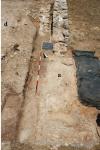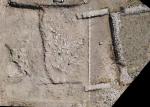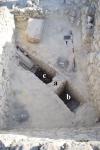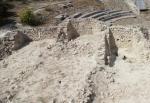Summary (English)
Research continued in the north-western corner of the forum where in the past a room was identified bordered by two sections of wall and with two beaten-earth floors with terracotta fragments, the earliest of which showed traces of burning. The entire area was heavily disturbed by agricultural activity; the floors were particularly badly damaged by the digging of a pit and three trenches (fig. 1 a-d). However, the negative evidence indicated that the silt deposit was very close to the surface in this area of the forum and that the floors were laid on natural with a minimal make-up. The fill of the pit, obviously with a silt matrix, contained pottery fragments, building materials, plaster, and bone fragments. The excavation was not completed and the materials are being studied.
A new wall was found outside the room, which further defines a new room to the east of the first, as suggested by the walls uncovered in 2016 (fig. 1, 1-3).
In the eastern part of the trench, the investigation continued of the quadrangular pits identified in 2016, which appeared of approximately uniform dimensions. The study of the numerous pottery fragments from the pits is ongoing but shows that the chronology does not go beyond the 5th century A.D. Further investigation will clarify the motive for their presence and deposition, as the data from this year does not seem to support the previous hypothesis.The north-eastern area of the forum was investigated in order to clarify the nature and function of a structure partially uncovered in the 1990s. The excavation remains to be completed but a floor made of terracotta fragments, cubilia and limestone fragments, and part of a badly damaged quadrangular structure built of the same materials (fig. 2) were identified. The only stratigraphy was terrain that was badly disturbed by ploughing.
Another trench was opened in correspondence with the south-western entrance to the temenos in order to check the links between this structure and the via glareata running parallel to it at a higher level along the west side (fig. 3).Theatre area:
Excavations continued in the south part of the theatre. The sector between the fortification and the post-antique rooms β and γ was deepened, but only reached more levels of disturbed terrain relating to the restoration of the medieval structure that took place in the 1990s (fig. 4).The 2016 excavations inside room δ uncovered part of a semi-annular sewer relating to the theatre and the wall built inside with reused materials it was identified. The archaic majolica found this season in the north-western part of the sewer dates the construction of the wall to the Renaissance period. The material in the fill in the south-eastern part dated to the collapse of the Roman theatre; this included large architectural fragments, fragments of coarse ware pottery and animal and human bone (fig. 5).
- Luisa Migliorati - Sapienza Università Roma
Director
- Luisa Migliorati - Sapienza Università Roma
Team
- A. Pansini - –Sapienza Università di Roma
- Claudia Micari
- Dario Canino
- Federica Pirré
- Giulio Casazza
- Ilaria Trivelloni - –Sapienza Università di Roma
- Leonardo Radicioni
- Luca Volpi
- Tiziana Sgrulloni





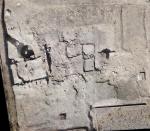
![Download [PDF]](/excavation/skins/fasti/images/results/download_sml.png)
